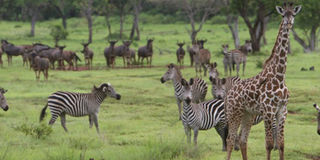Make the most from Selous wildlife census

What you need to know:
- Arguably, the main interest among conservationists in and outside the country as the experts conduct the 2017 Selous-Mikumi Mammal Census will be on the development of the elephant population.
A wildlife survey that began yesterday in Selous Game Reserve and Mikumi National Park is yet another important step in the country’s conservation efforts. Experts from the Tanzania Wildlife Research Institute, Tanzania National Parks Authority, Tanzania Wildlife Management Authority and Frankfurt Zoological Society are on the ground to determine the actual mammal population.
Arguably, the main interest among conservationists in and outside the country as the experts conduct the 2017 Selous-Mikumi Mammal Census will be on the development of the elephant population.
This is so because various reports have revealed the sad tale of how industrial scale poaching in Selous Game Reserve have depleted the elephant population, from about 45,000 in 2009 to an estimated 15,000 in 2014.
This led to the declaration of the country’s largest game reserve, famous for its pristine ecosystems and abundance of black rhinos, cheetahs, giraffes, hippos and crocodiles as well as elephant, as a World Heritage in Danger.
Selous Game Reserve, the oldest in Africa, boasted 110,000 elephants 40 years ago. Last year, the World Wildlife Fund (WWF) also warned that elephants in the game reserve could be wiped out by 2022. The nature conservation group cited “industrial scale poaching” driven by demand for ivory from Asian countries, particularly China – as the reason for the worrying trend.
Encouragingly, efforts by the government to tackle the corruption that allows the illegal ivory trade to continue have begun to pay off, according to recent statements by wildlife authorities, who early this year reported a “decline” in the illegal activities. But more still needs to be done – and a good point of reference as the authorities forge ahead with the anti-poaching drive is determining the exact numbers of elephants on a more regular basis.
The findings of this wildlife census, which is expected to be delivered to the Unesco World Heritage Committee next February, should inform the next course of action in this war.
Tanzania honoured again
Tanzania has yet again scooped an important slot on the African map. This time it’s about the Centre for African Heritage – whose headquarters will be built in Dar es Salaam following an agreement by stakeholders this week.
On Tuesday, Information and Culture minister Harrison Mwakyembe announced the news at a press conference in the city after a meeting with his South African counterpart. The proposed centre is a pivotal part of a programme that seeks to celebrate the continent’s liberation struggles – and the choice of Dar es Salaam is not coincidental.
Tanzania played a critical role in the liberation of many African countries; in particular Mwalimu Nyerere, who helped to popularise the concept of Pan-African unity, was a key figure in the struggle against foreign domination. This centre, therefore, would not have been given a better home. Tanzanians stand a chance to be the biggest beneficiaries of the centre.
Dr Mwakyembe told reporters that a similar centre would be built in Dodoma. Local schools will have a critical history resource centre in their own backyard.
Already, Tanzania is the seat of major regional and continental organisations, such as the African Court on Human Peoples’ Rights and East African Community, which are based in Arusha. This is a sign of growing confidence in the country.




